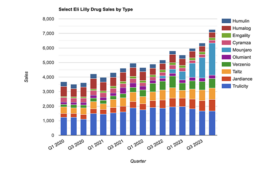
Without the encumbrances of patents or the peer review publishing process, a Canadian research consortium is taking an open science approach to try to foster new drug discovery breakthroughs.
Open science is a model in which researchers share their data quickly and publicly in a global community with the goal of accelerating scientific discovery. Starting in the 1990s with the Human Genome Project, the open science movement spread to protein structures and ultimately early-stage drug discovery through the Structural Genomics Consortium (SGC).
Aled Edwards, the director and CEO of SGC and the Banbury Chair of Medical Research at the University of Toronto, said during the annual American Association for the Advancement of Science Meeting on Feb. 16 in Washington D.C., that open science reduces the cost of new drugs, while yielding more success in clinical trials.
Edwards recently formulated a new organization dubbed Medicines 4 Neurodegenerative Diseases (M4ND Pharma) with the aim of developing new therapies for Parkinson’s disease, ALS and other neurological disorders, making it just the second company in the world committed to open science. His first open science company, Medicines 4 Kids (M4K Pharma) was launched in 2017 with the goal of developing novel drugs for an uncommon and fatal childhood brain cancer.
Agora Open Science Trust, a Canadian charity charged with supporting open science for the public good, owns both companies. Funds are raised from research organizations, including government agencies, foundations and corporate donors. Any proceeds generated through commercial partnerships go back to the charity.
All of M4ND’s data is currently available for public viewing in video recordings of their monthly open science meetings, which are available on YouTube.
In a traditional drug discovery business model, data isn’t shared when a particular target isn’t successful. This means that scientists at various organizations are doing the same work that others have already done, said Edwards.
“We don’t understand disease, so it really is a wild guess when they are taking the drug into the clinic,” he said. “Because they work on so few targets, every drug discovery program is actually done over and over and over again but most of these fail. It’s a ludicrous system.”
Edwards explained that about 90 percent of drug discovery trials fail during phase II, when they are actually tested in humans.
In the current business model, to incentivize drug discovery, medicines must be priced at levels that are too expensive for the majority of the world, said Edwards.
According to Edwards, $300 billion is spent annually on biomedical research worldwide, in both the public and private sectors. However, the money is not always spent effectively, largely due to a knowledge gap regarding our actual understanding of diseases.
“How do we make healthcare and health more equitable and what’s the big problem that open science can tackle,” Edwards said. “Unfortunately, we are not doing as well as we want, for many diseases we don’t even understand their molecular mechanisms, let alone how to design a therapeutic strategy. We are plowing money into these diseases and we still don’t know what causes them, let alone cure them.”
One of the tenants of open science is that both M4K and M4ND do not seek patents on any of their findings, but rather rely on regulatory protections such as data exclusivity for drug sponsors to prevent generic competition and orphan drug exclusivity for rare diseases. According to Edwards, these often provide longer protections in some cases than patents and shorter protections in other cases, depending on the country. For example, the data exclusivity period for human use drugs is five years in the U.S., eight years in the European Union and six years in Japan.
Edwards said data exclusivity, as well as other available protections, are sufficient enough to attract commercial partners wanting to manufacture, distribute and sell medications at a reasonable price that will not be undercut by counterfeit drugs on the black market.
“Why don’t we make the price low enough where it can’t be undercut,” he said.
SGC, which was founded in 2003, now includes more than 300 research scientists operating in labs in seven leading academic institutions, including in Canada, the U.S., the U.K., Brazil, Sweden and Germany. In 2006, SGC developed their no-patent policy, which applies to all SGC scientists and collaborators. In total, SGC contributors publish about 2.5 scientific research papers per week, representing about 30 percent of papers that appear in the highest tiers of journals. In addition, more than 40 clinical trials have been launched due to SGC science and about 10 companies started from the open science initiative.
Filed Under: Drug Discovery




